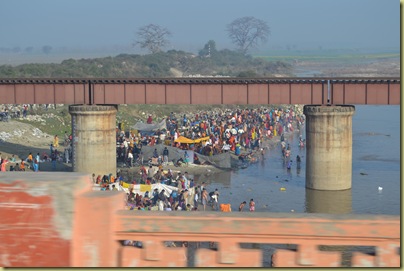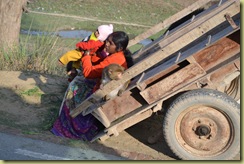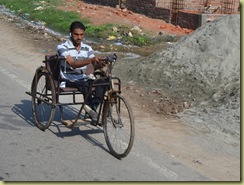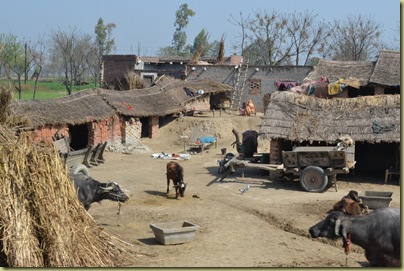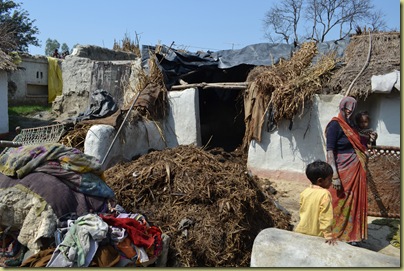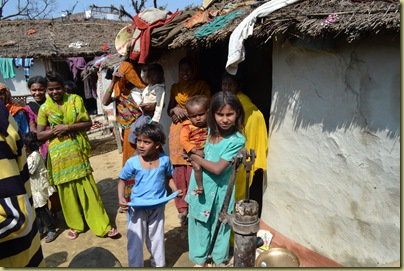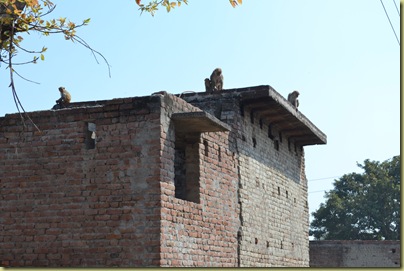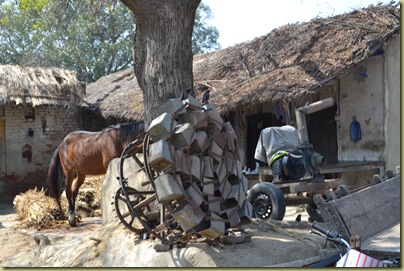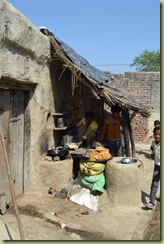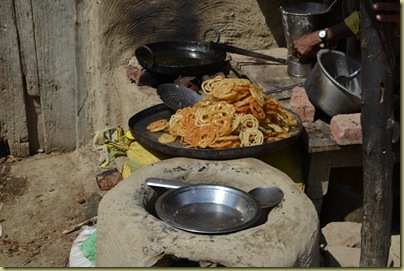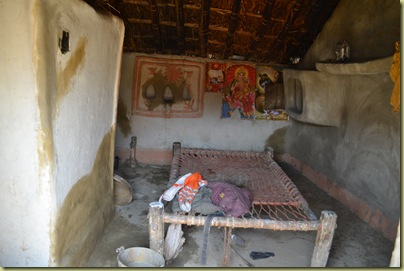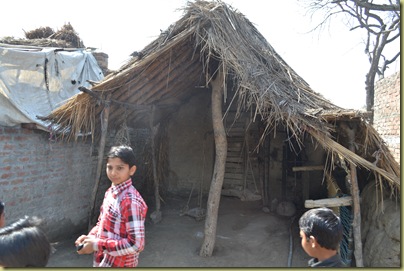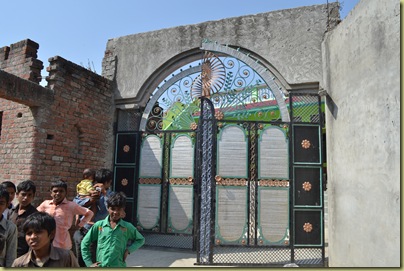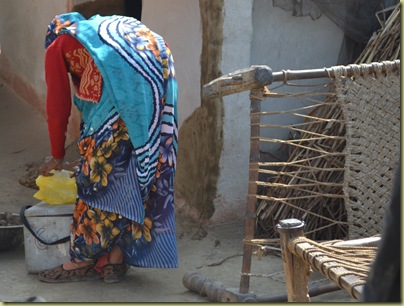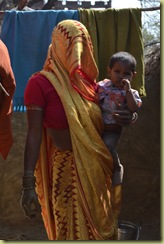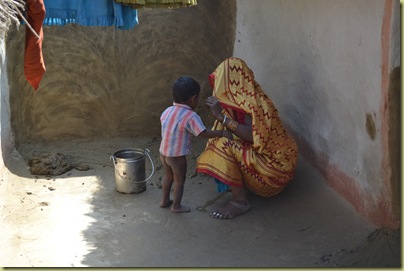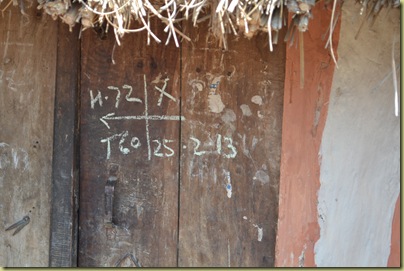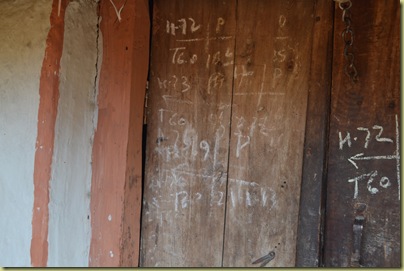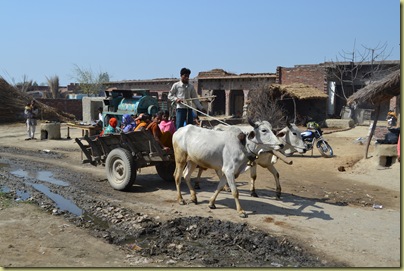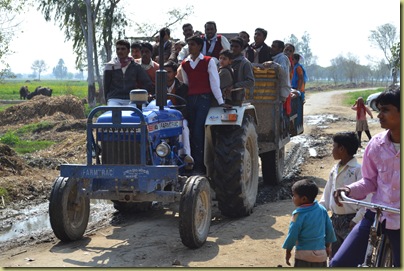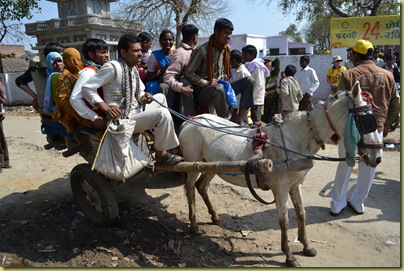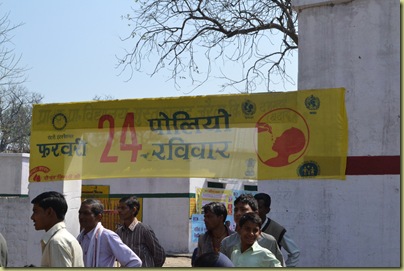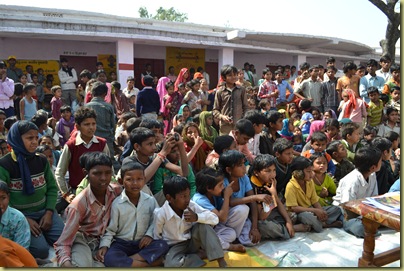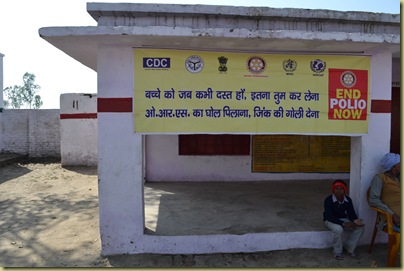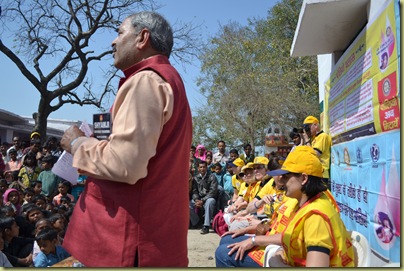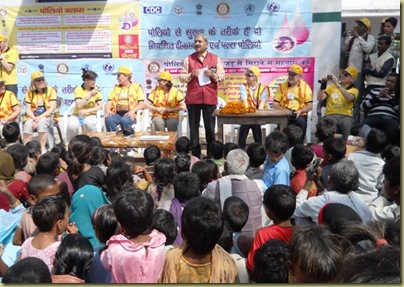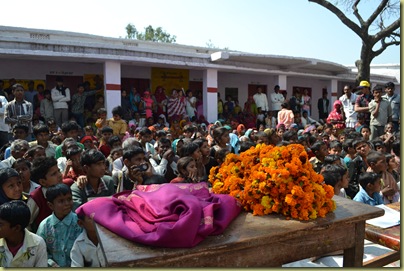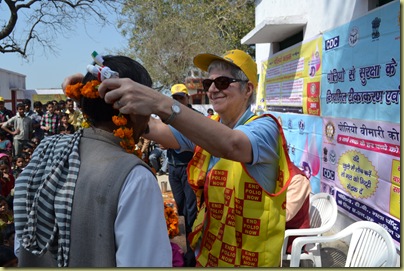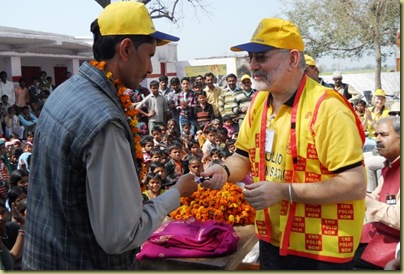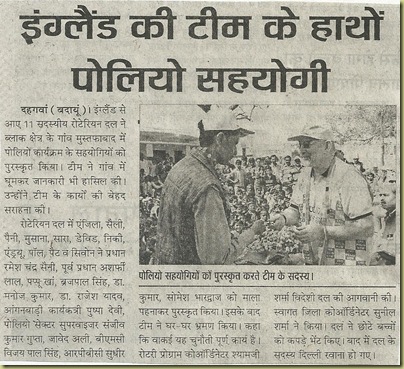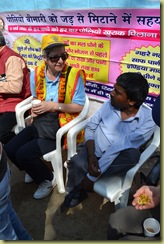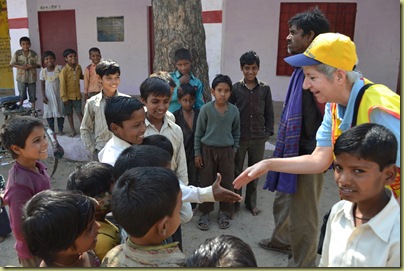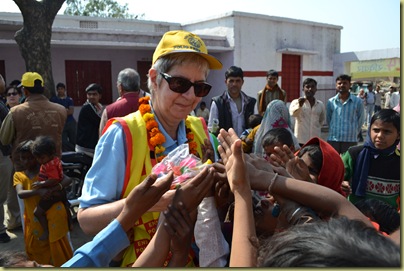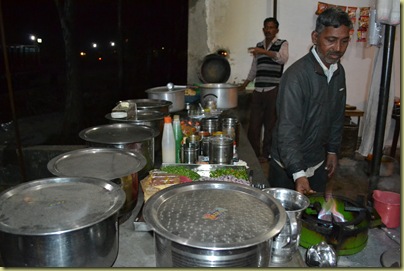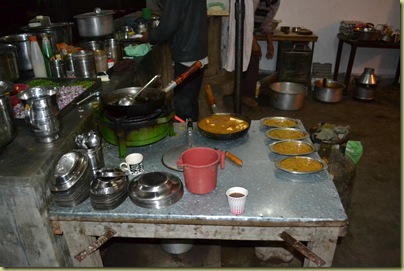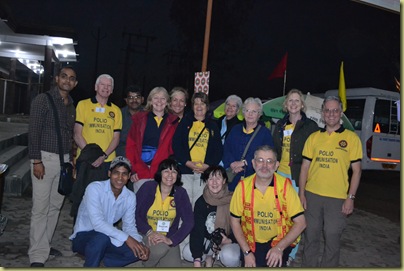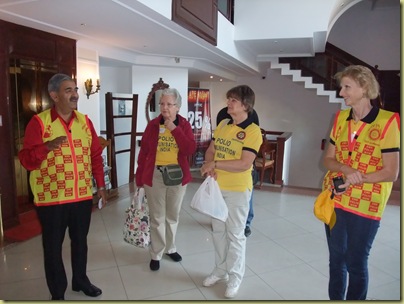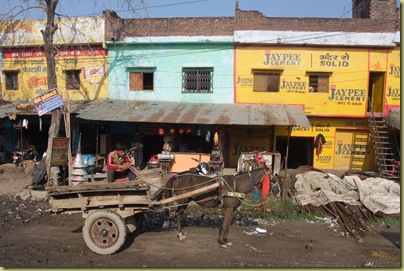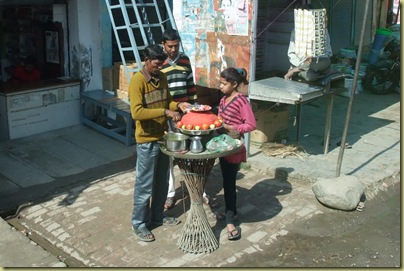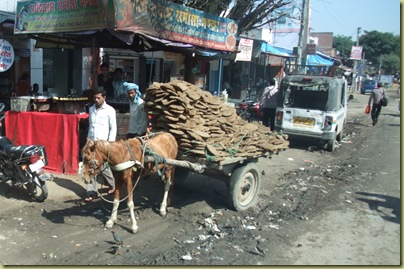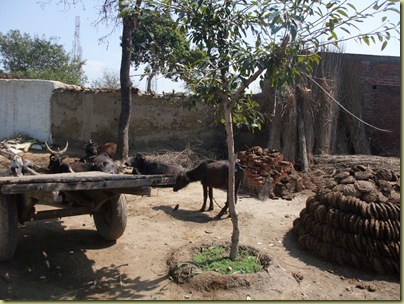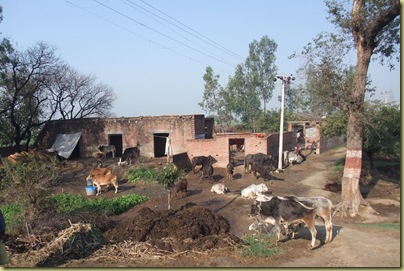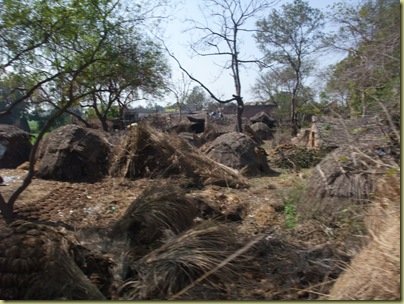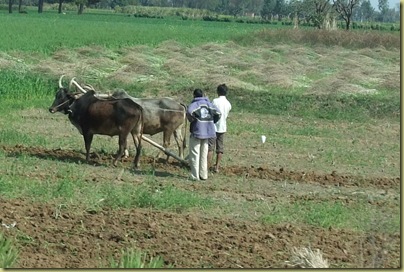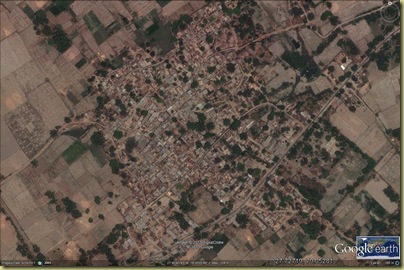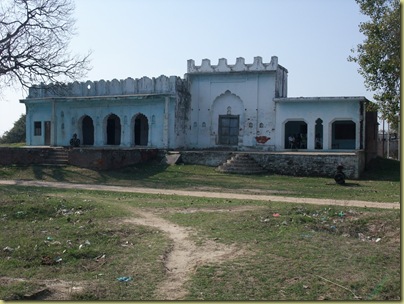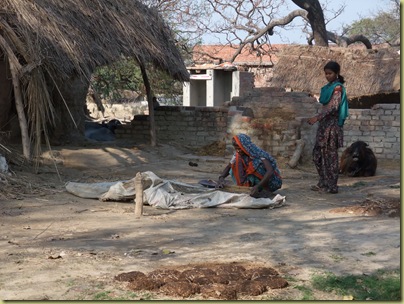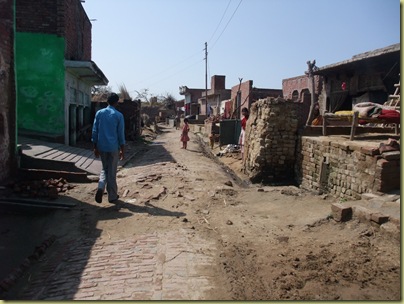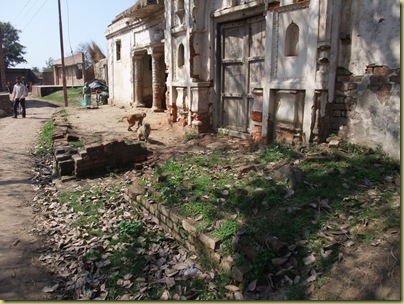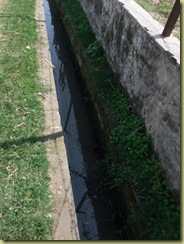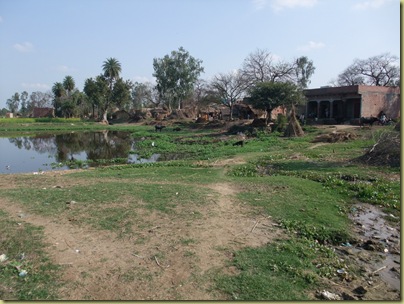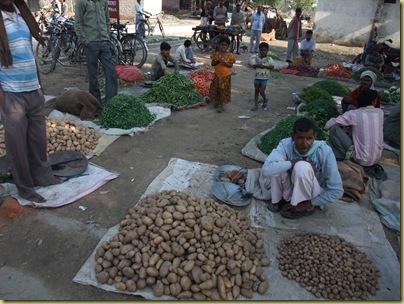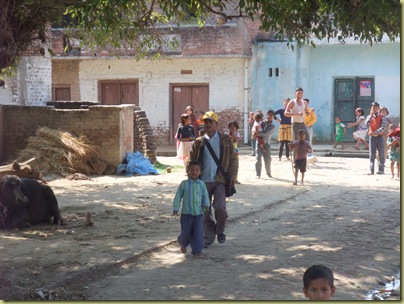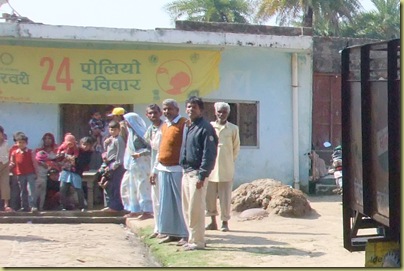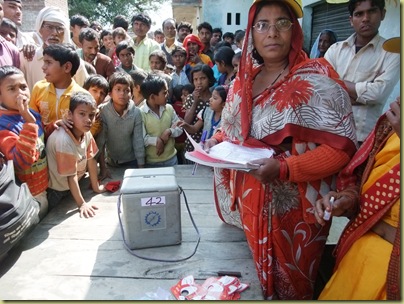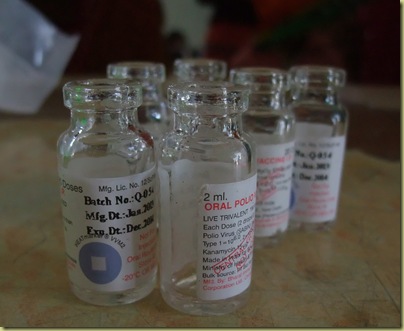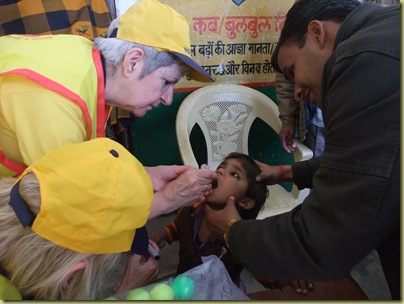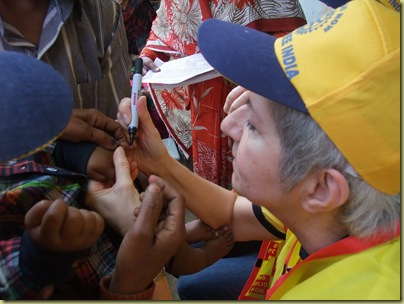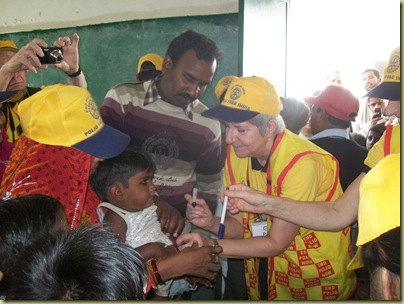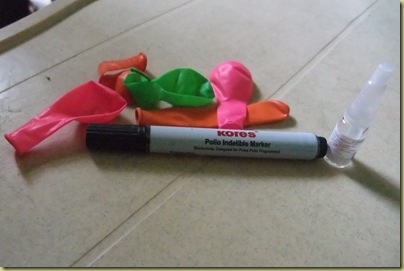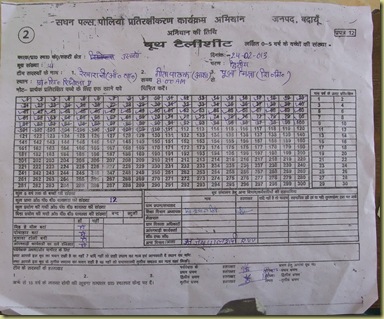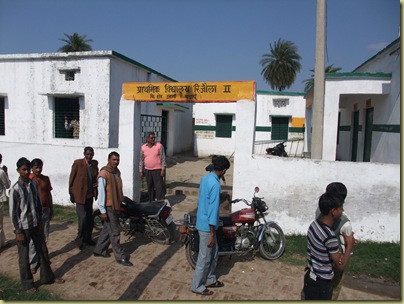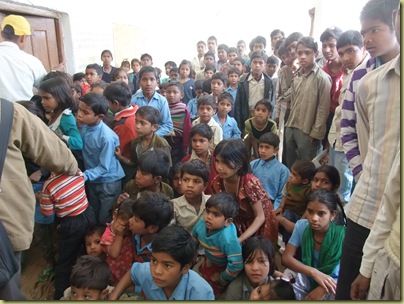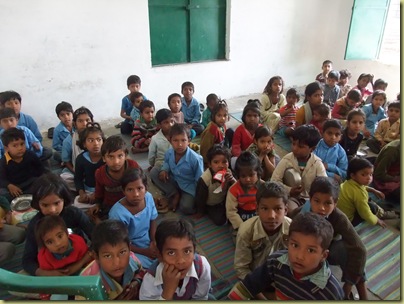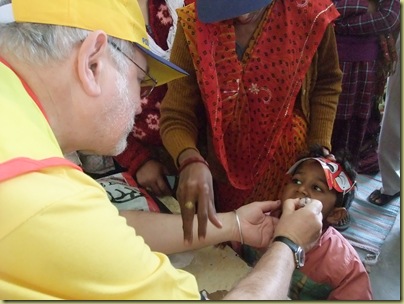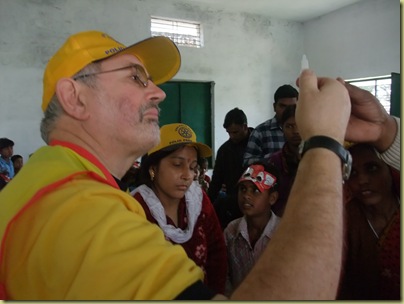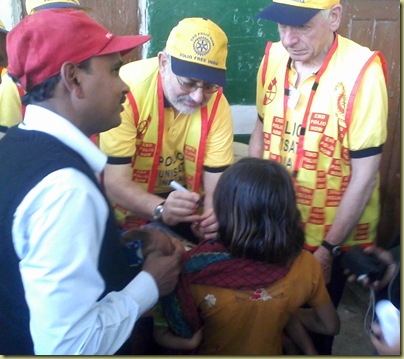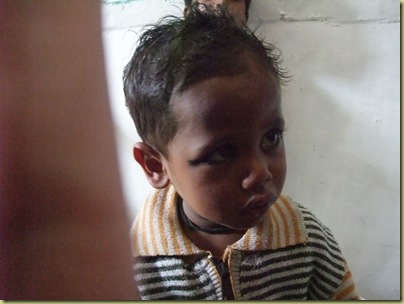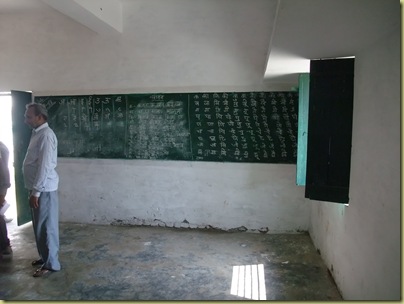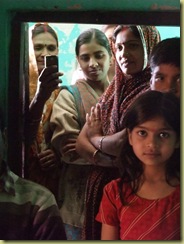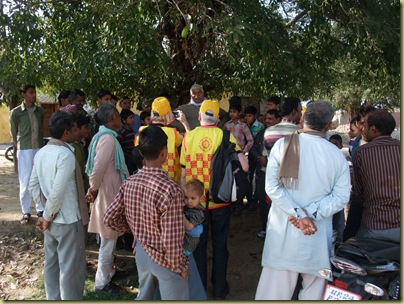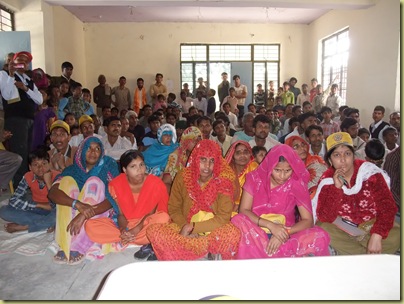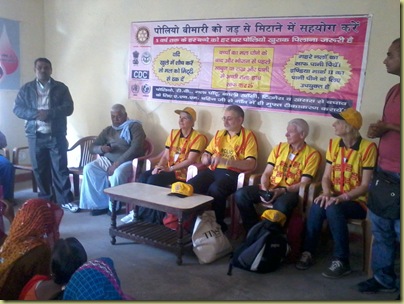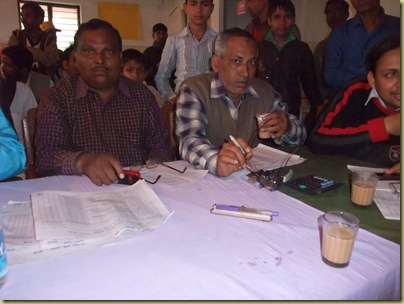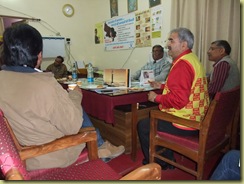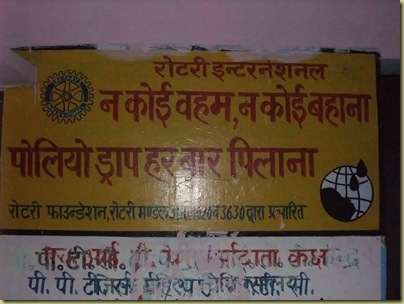Sunday was vaccination day when every child was vaccinated. Monday is follow-up day when every household is visited and the children there are checked for the magic “Purple Pinkie” mark. Then the house is “chalked” with the result of the visit.
We checked out of the hotel and headed off to the village of Mustafabad Jaretha which is in the Dahgawan Block of the Badaun District. According to the Indian 2011 Census this village has 274 houses and a population of just over 1800 of whom 43% are female – it is small by any measure.
A few kms out of the town, we crossed the Ganges and because it was an
“auspicious day” (Purnima – a full moon), lots of people were bathing in the river because it is regarded as a holy river. 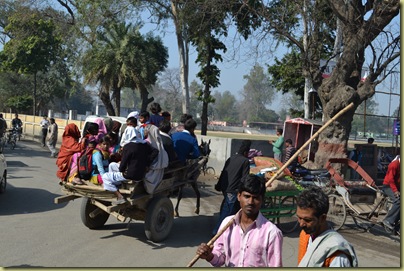
We also passed lots of people heading towards the river using every possible mode of transport.
These people were waiting for a tractor cart and whilst resting, a monkey decided to sit down with them – monkeys are regarded as a bit of a pest in this area because they eat the crops.
We also passed someone who appeared to have suffered from polio and hence had a hand propelled tricycle to get himself about.
The countryside gradually became even more
rural and undeveloped and the reactions of the people we passed expressed more and more curiosity but as soon as they saw the magic words (in Hindi) which said Polio, great smiles appeared.
We reached what we thought was the village because we had turned off the main road and stopped in what appeared to be a very undeveloped place, but this simply was a pause to pick up a guide for the next section of track which took us far out into the countryside down an unmade track to Mustafabad.
This village is certainly undeveloped and it must have been
a bit of a shock for the villagers when 11 brightly dressed Europeans appeared with numerous health workers and started to spread out around the village.
The children of course were curious and the least shy about coming to see whom we were.
The monkeys observed us from the roof tops
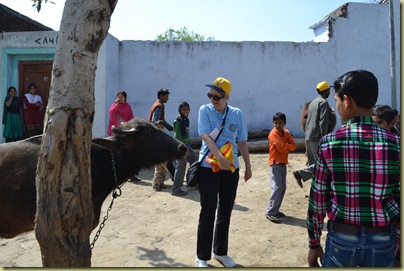 whilst the cows decided to get friendly and sniff Pat out.
whilst the cows decided to get friendly and sniff Pat out.
The village is hoping to improve its water supply with this water wheel made out of some old cast iron parts and tin cans fixed in an appropriate shape. Nothing is ever wasted in India.
We wished we were brave enough to try some food from a
local stall – this one was selling Samosas but our caution over hygiene stopped us.
We were able to see inside of a couple of houses,
the inside of this house is typical of many of the poorer houses in the village
and this one was only a few yards away and was even more basic.
The village is typical of many in UP and the living standards vary from very basic through to very comfortable,
one or two people obviously having got money from somewhere.
India is a puzzling country with significant wealth being side-to-side with significant poverty. Those living at the bottom (whom we spoke to) seem to believe that India was a poor country and therefore their position was not unusual. It is poor in a lot of parts but it is also very wealthy in others.
The really impressive part of the Polio Vaccination process is that every house with a child in it is visited and checked after vaccination day and that vaccination is not optional, such is the determination of Government to rid India of Polio. 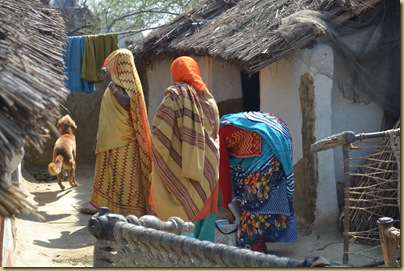
Here a mother is visited by Vaccinators and asked about her children
If the child is found not to be vaccinated, then it will be done immediately, the vaccine being in the cool box.
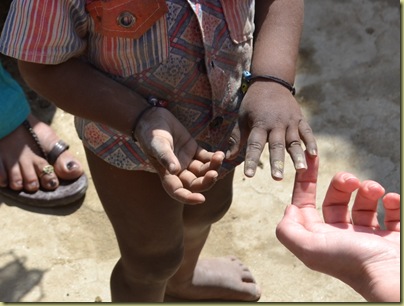 This child was found to have been vaccinated.
This child was found to have been vaccinated.
 So the records are updated and the building is chalked up with the sign for a successful visit.
So the records are updated and the building is chalked up with the sign for a successful visit.
The mother and child see us off
and she gets back to her plastering with a mixture of buffalo dung and mud and straw.
The coding system used is that X means not checked because either no one is in or the child is out – the system
then requires that visits be repeated until they know what happened.
P means that the child(ren) living in this house have been vaccinated. And this door has multiple chalkings still showing on it from earlier vaccinations – the most recent previous one being in January 2013. There are scheduled to be 10 vaccinations in 2013 with every child being vaccinated every time.
Other doors have a messages on them from the local field worker.
This one says that it is vaccination day in a weeks time on the top two lines and then underneath it is the message showing that the house (the 73rd that day) was visited and the child(ren) inside Passed the check, the visit was carried out by Team 60 on 25-2-13.
After checking a number of houses and seeing how the process worked, it was village meeting time and villagers
arrived by every mode of transport.
The meeting was held in the playground of the local school
over whose entrance was a banner about the NID on the 24th (note the Rotary symbol bottom right) and soon the school yard was packed with people
sitting near to another banner which recorded whom (including Rotary) had funded the Polio eradication drive.
In the audience you could again see both poverty and mobile phones – here the phones being used to take photographs of me.
There followed speeches,
and garlands and small gifts being given in both directions.
We even featured in the local press.
and the meeting finished with snacks and offerings of water which came from
the local well. Although only one of our number suffered stomach problems during our time in the field, she felt really ill and so we were very careful when offered local water.
There was a Polio victim living in the village who had caught the disease 25 years ago when he was 5, the results of which meant that he had no use in his legs and his hands were deformed. He accepted without bitterness that the disease which had caused him so much suffering was now on the verge of extinction but he did comment that he had a very hard life and received virtually no support from the State.
Afterwards, the children wanted to shake hands
and to get one of the balloons from our remaining supplies.
Eventually we managed to leave and to head in the direction of Delhi (or so the driver believed) for the supposed 3 hour drive back.
A few hours after leaving (when we were starting to get hungry) we stopped in a town to buy some fruit in the market. The sight of people dressed in yellow getting off a bus caused quite a stir but as soon as we mentioned the words “Polio, Rotary” and made the hand gestures of using the polio dropper, people starting shaking our hands and thanking us in their own languages – we could not understand the words but the meaning was obvious. The stall holders then changed their pricing policy for the fruit we were buying and sold to us a local prices – not that charged to gullible tourists (although they probably did not get many of any nationality in that isolated town) and one man came up to me and said he was a local Rotarian and he was honoured to meet us and thanked us for what we were doing.
Such a reaction was very common throughout our time in India – one of a group reported that when her tuctuc driver realised she was a Polio volunteer, he refused to take payment for the ride.
Some eight hours later we arrived in Delhi having been lost twice and stuck in traffic for nearly an hour on the middle of a railway level crossing. Once we realised that we were not going to get to Delhi by any civilised time, we stopped at a truck drivers cafe some 50 kms from Delhi and had the most wonderfully authentic alfresco Indian dinner of whatever he
had cooking in the kitchen bar the salad 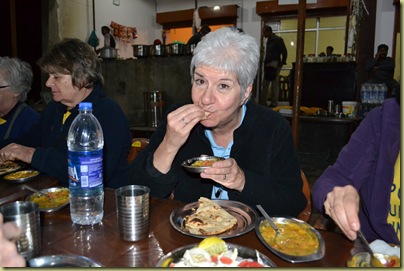
and we had a wonderful meal for 200 rupees (less than £3 each).
Well done Team Sally! – Angela Winson, Penny Underwood, Nicky Creed, Andrew Davies, Sally Hoadley from Brue Valley; Siobban McKay from Dungannon; Susannah Garton from Holmes Chapel, Sarah and Richard Hughes from Marlow Thames; and Paul and Pat Harvey.
So how was the NID for us?
We are absolutely delighted we came and thoroughly enjoyed every moment. It has been an experience never to be forgotten.
After the overnight flight, we were very tired on the first day on Delhi and therefore next time, would come out a day earlier in order to get used to the time change.
The briefing on arrival was short and thorough and the information we received in our briefing packs was useful. Indian shirt sizes (we all ordered and purchased special yellow Polio t-shirts in advance) are on the small size so it may be advisable to order one size larger than you are. Also it is reported that they shrink when washed.
The hotel in Delhi was quite comfortable and acceptable other than that the price of food and drink in the hotel was very expensive and if you have the energy, it is worth going into town. The charge for WIFI at the hotel is extortionate.
The hotel we stayed in at Bareilly was acceptable for a short stay, the food was reasonable and the hotel had free WIFI. In general, free WIFI is not readily available in India.
We had no trouble in getting our clothes washed at hotels although some of the group reported getting theirs returned close to check-out time.
Indian hotels seem not to do packed lunches or breakfasts very well (we base this comment on four packed meals) and so we were grateful for the various bars and snacks we brought with us from the UK to cover just such an eventuality.
We took old trainers with us to wear out in the villages, the plan being to throw them away if they got too muddy and mucky. In the event, the ground was relatively dry.
We were glad we chose a rural location as against a town because it would appear that we got more “hands on time” than some of those who chose Delhi or Lucknow. The downside to this was that we had a lot of coach travel – what we saw and experienced was very interesting but the travel was tiring.
The journeys we undertook were not for the travel sick not for the travel nervous. Most of the roads were very bumpy and Indian driving is an experience you will never forget (or probably ever get over). After a while we got used to the constant “Marigold Moments” – if this does not mean anything to you, read the Darjeeling blog entry which follows.
The villages we were taken to for the NID gave us an experience we will never forget. The welcome and hospitality offered by someone who had nothing was astonishing. The first booth we went to had started work at 8 am so by the time we arrived (11.30) most of the children had been vaccinated. There were plenty of children at the next booths however.
Feedback meetings with various layers of Indian officialdom are part of the package and provided some useful information.
The follow-up day was interesting in that we saw how it worked but we had no hands on experience. The village we went to was even more of an eye opener than the previous day.
We might not take pencils and pens next time but concentrate upon balloons, whistles and balls etc. Toothbrushes were not much use in the villages because toothpaste is not readily available. We gave all of our left-over gifts to the local coordinators for them to use during the next campaign.
We had no trouble in finding supplies of bottled water – most of it looked reliable, a couple of bottles we wondered about. Hence we were grateful for the spare bottles we kept in our bags for just such an eventuality.
None of our internal scheduled flights departed at the time on the ticket – they were all rescheduled, some earlier some later. Checked luggage weight limits of 20kg for internal flights were strictly observed and some bags mysteriously gained weight which a few rupees removed. No weight limit seemed to apply to hand luggage. The time it took to get through the airport (security etc) varied from 1 hour to 2½ hours, Delhi being the worst. Allowing ample time is essential.
The food we were offered whilst out in the field was superb and we enjoyed eating it very much. Whenever possible, we restricted ourselves to freshly cooked food and avoided salads (you do not know the quality of the water used to rinse it). Bananas were ok, we avoided grapes, apples etc. Politeness did mean that on occasions we had to take a risk.
Access to toilets was sometimes problematical and we had to ask on a number of occasions for a “rest break”. Toilet paper is not the norm outside of hotels and therefore we took our own.
We did not suffer from any stomach problems during our time here, perhaps because we were very careful to only drink bottled water or tea, we avoided salads and fruit, we used hand wipes and hand disinfectant etc. We did not take malaria tablets (on advice we were told it was not needed) but some of the group did.
We were able to recharge our array of electronics using European two pin converters although next time we will purchase a three round pin Indian converter (from Amazon) because some of the sockets we found were difficult to use.
We were welcomed by all of the Rotary groups we met and it was very nice to be able to participate in the international fellowship which all Rotarians believe is such an important part of Rotary life. We took a few club banners and a couple of books about our home town with us as gifts for the clubs we visited.
Tipping is a constant thing in India and applies to everyone who gives you a service not matter how routine. There are plenty of others who try to do something for you which you did not ask for or may not even want in order to extract a tip (refuse to tip). Hence keeping a supply of small notes (10s, 20s, 50s) is essential. No one likes to be given old or torn notes.
With some sensitivity, we were able to take photographs whenever we wanted to although some people expected a tip.
We were not troubled by many of those living on the streets nor subjected to any hostility. Our group followed the advice of not giving on the streets but donating to charitable groups we met if they wanted.
Has Rotary made a difference in India?
Absolutely and categorically Yes – this is the view of everyone we met from people in the villages through to Chief Medical Officers. Every person we met expressed tremendous gratitude to Rotarians across the world for their commitment to the Polio campaign and we felt proud to be part of that commitment.
Would it have been better to have donated the money we spent on going to India to the cause rather than travel there and take part? The view of everyone we met (and our view) is No.
The fact that we were in India
- increased the take-up of vaccine at booths .
- increased the numbers attending briefing meetings.
- provided moral and practical support to a group of field workers who have been battling Polio for many years and are now feeling a little tired
- enabled the people of India (at all levels) to share their delight at almost beating this disease with others
- enabled us to talk with authority about how Rotary funds have been used to save lives in India
We would come again given the opportunity, it was an eye-opening experience and a privilege to be part of Rotary’s Polio Team.
Thank-you to all of the Indian Rotarians we met, in particular Shyamji Sharma. A very special thank-you to Mike and Bernice Yates without whom we would not have been able to go. And a thank-you to the Badaun team and all of the fellow Rotarians we met during the February 2013 NID.
